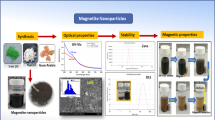Abstract
Herein, we describe a uricase immobilized Au/Ni/PANI microrocket for the motion-based potential hyperuricemia therapy platform. This study has aimed to investigate the use of uricase immobilized magnetically guided microrockets to lower the uric acid level. The outermost Au layer of the microrocket facilitates the immobilization of the uricase enzyme, while the Ni layer allows controlling the motion of the microrocket via an external magnetic field. The innermost layer of PANI was integrated to prevent Ni from leaking. Optimum parameters for enzymatic reactions were determined, and optimum pH for free and immobilized uricase was found to be as 8.5, while optimum temperature was 35 °C for both uricase preparations. Also, the kinetic parameters of both free and immobilized uricase were evaluated. Km value for free uricase was found to be as 0.1212 mM, while immobilized uricase demonstrated lower Km value of 0.017 mM. Vmax of free and immobilized uricase was found to be as 0.8613 µmol/min and 0.02685 µmol/min, respectively. The immobilization process caused uricase to exhibit advanced stability for medium pH, resistance against protease enzymes, improved storage stability, and reusability. It was also observed that the substrate affinity for uric acid increased significantly after immobilization. As a model experiment, activity experiments were performed in an artificial serum medium to demonstrate the potential of the proposed system for future in vivo use. Artificial tests indicated that uricase-modified microrockets showed higher enzymatic activity than that of free counterpart and enzyme-free control studies.
Graphical Abstract








Similar content being viewed by others
References
Sherman MR, Saifer MGP, Perez-Ruiz F (2008) PEG-uricase in the management of treatment-resistant gout and hyperuricemia. Adv Drug Deliv Rev 60:59–68
Ming J, Zhu T, Li J et al (2021) A novel cascade nanoreactor integrating two-dimensional Pd-Ru nanozyme, uricase and red blood cell membrane for highly efficient hyperuricemia treatment. Small 17:2103645
Tandon S, Sharma A, Singh S et al (2021) Therapeutic enzymes: discoveries, production and applications. J Drug Deliv Sci Technol 63:102455
Cheung WL, Hon KL, Fung CM et al (2020) Tumor lysis syndrome in childhood malignancies. Drugs Context 9:1–14
Bomalaski JS, Clark MA (2004) Serum uric acid-lowering therapies: where are we heading in management of hyperuricemia and the potential role of uricase. Curr Rheumatol Rep 6:240–247
Rodríguez-Delgado MM, Alemán-Nava GS, Rodríguez-Delgado JM et al (2015) Laccase-based biosensors for detection of phenolic compounds. TrAC—Trends Anal Chem 74:21–45
Sassolas A, Blum LJ, Leca-Bouvier BD (2012) Immobilization strategies to develop enzymatic biosensors. Biotechnol Adv 30:489–511
Schultz MJ, Shanov VN, Yun Y (2009) Nanomedicine design of particles, sensors, motors, implants, robots, and devices. Artech house, London
Serrà A, García-Torres J (2021) Electrochemistry: a basic and powerful tool for micro- and nanomotor fabrication and characterization. Appl Mater Today 22:100939
Vyskočil J, Mayorga-Martinez CC, Jablonská E et al (2020) Cancer cells microsurgery via asymmetric bent surface Au/Ag/Ni microrobotic scalpels through a transversal rotating magnetic field. ACS Nano 14:8247–8256
Ma X, Hortelão AC, Patiño T et al (2016) Enzyme catalysis to power micro/nanomachines. ACS Nano 10:9111–9122
Serrà A, Vallés E, García-Torres J (2017) Electrochemically synthesized nanostructures for the manipulation of cells: biohybrid micromotors. Electrochem Commun 85:27–31
Wang J, Gao W (2012) Nano/microscale motors: biomedical opportunities and challenges. ACS Nano 6:5745–5751
Bradford MM (1976) A rapid and sensitive method for the quantitation of microgram quantities of protein utilizing the principle of protein-dye binding. Anal Biochem 72:248–254
Mahler JL (1970) A new bacterial uricase for uric acid determination. Anal Biochem 38:65–84
Pui CH, Jeha S, Irwin D et al (2001) Recombinant urate oxidase (rasburicase) in the prevention and treatment of malignancy-associated hyperuricemia in pediatric and adult patients: results of a compassionate-use trial. Leukemia 15:1505–1509
Godoy M, Moreno AJ, Jorge GA et al (2012) Micrometric periodic assembly of magnetotactic bacteria and magnetic nanoparticles using audio tapes. J Appl Phys 111:044905
Nam K, Kimura T, Kishida A (2008) Controlling coupling reaction of EDC and NHS for preparation of collagen gels using ethanol/water co-solvents. Macromol Biosci 8:32–37
Tan QY, Wang N, Yang H et al (2010) Preparation and characterization of lipid vesicles containing uricase. Drug Deliv 17:28–37
Acknowledgements
S. Evli and B. Öndeş thank the Higher Education Council of Turkey (YOK) for 100/2000 PhD scholarship and TUBITAK for the 2211C BIDEB PhD scholarship.
Author information
Authors and Affiliations
Corresponding author
Ethics declarations
Conflict of interest
The authors declare that they have no conflicts of interest.
Additional information
Publisher's Note
Springer Nature remains neutral with regard to jurisdictional claims in published maps and institutional affiliations.
Supplementary Information
Below is the link to the electronic supplementary material.
Supplementary file1 (MP4 7143 KB)
Rights and permissions
Springer Nature or its licensor holds exclusive rights to this article under a publishing agreement with the author(s) or other rightsholder(s); author self-archiving of the accepted manuscript version of this article is solely governed by the terms of such publishing agreement and applicable law.
About this article
Cite this article
Uygun, M., Evli, S., Öndeş, B. et al. Uricase Modified Au/Ni/PANI Microrockets to Reduce Uric Acid Level. Catal Lett 153, 1564–1573 (2023). https://doi.org/10.1007/s10562-022-04123-y
Received:
Accepted:
Published:
Issue Date:
DOI: https://doi.org/10.1007/s10562-022-04123-y




